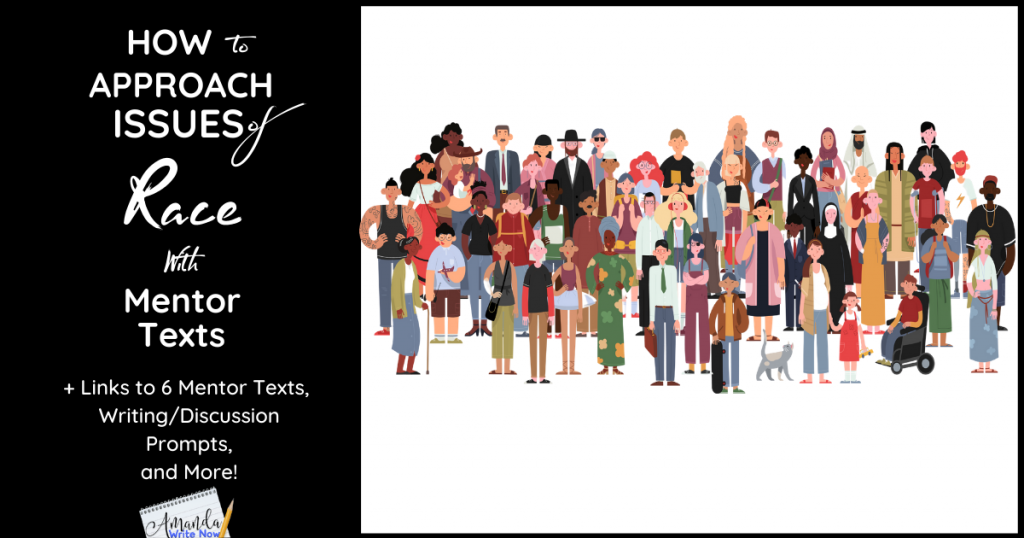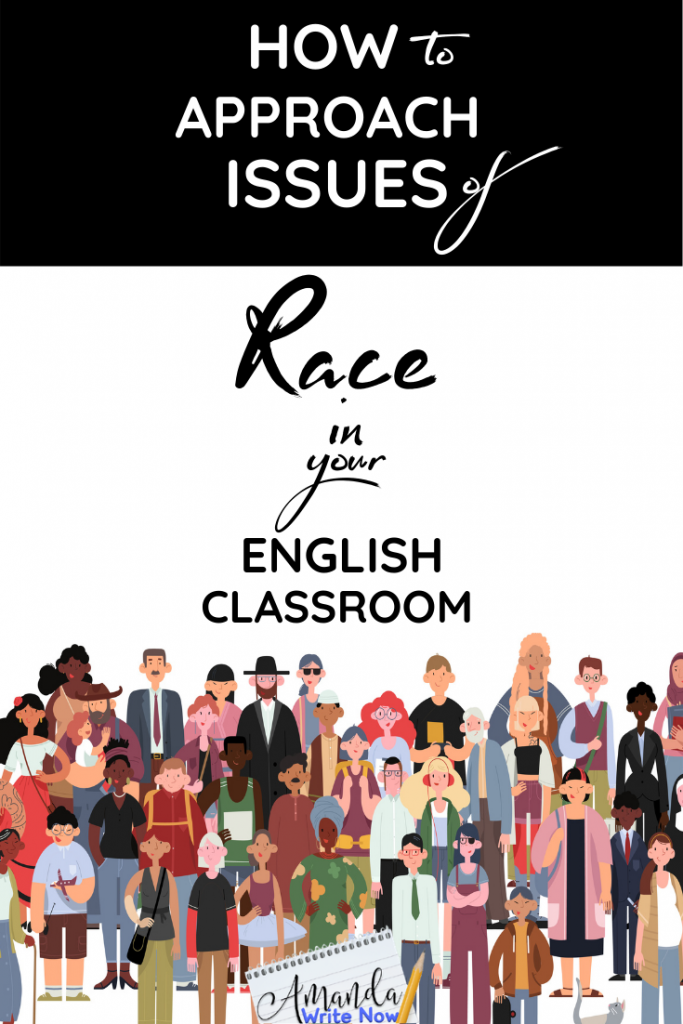
Our classrooms are microcosms of the society we live in.
The sad reality (that many have a hard time admitting) is race matters in our society and it matters in our classrooms.
The majority of teachers in America are white and female.
Schools and neighborhoods are segregated by race.
Students socially group themselves by race (and so do adults).
Everyone who walks onto a school campus (or in neighborhoods) sees these realities and yet very few people (especially white people) talk about it.
A person’s race impacts so many aspects of their day to day experiences. When we ignore this fact or pretend to be colorblind, we are perpetuating the problems of stereotyping, prejudice and systemic racism.
Start by Reading…

I highly recommend Why Are all the Black Kids Sitting Together in the Cafeteria? by Beverly Daniel Tatum (*Amazon Affiliate Link). In this book, Tatum helped me realize that students of the same race need each other for support. It’s a rough world we live in. She helps educators realize racial grouping is a natural reaction to find comfort in people who have similar experiences as you.
The most surprise thing I learned from this book is that racial grouping within schools can actually be helpful and empowering for students when schools organize and support these groups.
Social groups or clubs created based on race within a school can promote discussion, reflection, support and community. When students are part of a supportive community, students begin developing more positive feelings about their own race and feel a sense of pride for being a member of this group.
If this grouping is frowned upon however, it can cause increased tension between different racial groups and between teachers and groups as well.
I believe there is a big problem with never talking about how race impacts our students’ lives and experiences.
Teachers everywhere are realizing the importance of approaching topics of race with students. Most quality teachers realize there is so much more to teaching than just content.
Educators are waking up, reading voraciously and reflecting a lot. I know that if you are reading this, you are one of those educators, dedicated to making a change.
How Do We Begin with Our Students?
We as teachers have the responsibility not only to teach content but to also help students develop positive feelings about who they are and where they come from.
But, many are wondering…how in the world do we do that?!?
How do we approach issues of race with our students?
How do we help students develop their racial identities and consider how race impacts our lives?
I don’t pretend to have all the answers. I’m still reading and learning and incorporating what I learn in small, incremental ways. For now, I’m leaning a lot on mentor texts. If you are new to mentor texts click here for an overview of what they are: How to Use Mentor Texts, Top Ten Places to Find Mentor Texts.
About the Mentor Texts
Below you will find six mentor texts that have themes surrounding issues of race and identity. For each mentor text I include a summary of the text, questions to write about and then discuss, lines from the text that students can “borrow” for their own writing and “mentor text moves” used within the text.
How to Use the Mentor Texts
In general I recommend just reading these mentor texts with students and allowing students to write their responses to the issues brought up.
I wouldn’t force students to discuss if they aren’t comfortable.
Be open and honest with students about how uncomfortable it can be to express your thoughts and opinions to a group of people.
This is why, before initiating any kind of discussion that you make time for students to get to know you and each other. I have many community building activities you can try listed in this post: Distance Learning Community Building Activities.
1. American Like Me by America Ferrera
Summary
In this short story America describes the many negative experiences she has had throughout school because of her name. The first day of school and every day after that is terrible for America because many of her teachers (particularly history teachers) and classmates always have something to say about her name. They think they are being positive and uplifting and what they don’t realize is they are just being insensitive and ignorant.
Discuss/Write About
What do you wish your teacher and classmates knew about you?
Has a teacher or an adult ever embarrassed you before? What happened?
What does being patriotic mean to you?
Borrow a Line
“My name is__________________and I’m_____________years old.
I_______________________my name”.
“I know just how lucky I am to be an________________________.”
“I learn to go along with_________________________.”
Mentor Moves
- Inner thinking vs. dialogue
- Commas
- Purposeful Run-ons
2. Fish Cheeks by Amy Tan
Summary
Amy’s parents are getting ready for Christmas Eve dinner and decide to invite the minister’s family. Amy is mortified. She’s in love with the minister’s son and doesn’t want him to see the different traditions her family follows including eating raw foods, licking chopsticks and belching to show satisfaction in the meal. Amy’s mom teaches her an important lesson about shame when the minister’s family leaves.
Discuss/Write About
Have you ever been in love? Write about that experience.
Have you ever been embarrassed by your family? Why?
What traditions does your family practice? Do you ever share those traditions with your friends or significant others?
Borrow a Line
“I fell in love with__________________________________.”
“When I found out my parents had___________________.”
“___________________ threw me into deeper despair.”
Mentor Moves
- Similes
- Imagery
- Flash back and flash forward
3. Hello My Name is…by Jason Kim
Summary
Jason describes his experiences immigrating from Korea to America and changing his name. He describes how difficult it was to find his identity for his entire school and young adult life, being torn between two worlds. He spends much of his first few months at his new school in America isolated from other children feeling desperate to be white so that he could fit in. His main goal throughout school was to fit in. It’s only later in life that he finally realizes that children should not have to change themselves or their names to fit in.
Discuss/Write About
Has anyone ever mispronounced your name? What did you do?
Why do you think people feel the need to “Americanize” their names?
Do you have a nickname? How did you get it?
Would you ever consider changing your name? If so what would you change it to? Why?
Borrow a Line
“I will never forget the day I___________________.”
“I’ve always been terrified of speaking up on behalf of___________________.”
“My dream now as a___________________is for our country to be___________________.”
Mentor Moves
- Dashes
- One-word paragraphs
- Dialogue
4. Indian Education by Sherman Alexie
Note: includes racial slurs and mature scenes.
Summary
Sherman Alexie grew up on a reservation in Spokane, WA and attends the tribal school there. In 7th grade he transfers to an all white school. He describes in vivid detail many negative experiences throughout his young life. But, he also describes bright and beautiful moments too.
Discuss/Write About
Alexie writes about many negative experiences living and going to school on a reservation, then he transfers to a mostly white school for a “better education”. Why do you think schools are so different in America? Do you think there is anything that can be done about this? If so, what do you think could be done?
Start from kindergarten and list vivid memories from each grade. Write just a sentence or two. Do you notice more positive or negative memories dominate?
Borrow a Line:
Page 2: “In third grade_____________________.”
Page 3: “I picked up a_____________________ for the first time and_____________________.”
Page 9: “When we look in the mirror, see_________________________ in our eyes, taste___________________, and shake with ___________________, we understand completely.
Mentor Moves:
- Chronological Organization Structure
- Headings
- Hyperbole
- Italics
5. My Name by Sandra Cisneros
Summary
In this short vignette from The House on Mango Street Esperanza contemplates the mixed feelings she has about her name. She describes the meaning and history behind it. She was named after her great-grandmother who was a strong woman until she was stolen away and forced to marry. Esperanza wants a new name that represents her true self, that no one truly knows, except her.
Discuss/Write About
Do you know what your name means? If so, what? Are you proud of your name? Why or why not?
Would you change your name if you could? Why or why not?
What do you think of the quote, “the Chinese like the Mexicans don’t like their women strong?” Do you think this is true of other races too? Why or why not?
Borrow a Line:
“In English my name means_____________________. In _____________________ in means _____________________.”
“At school they say my name _________________________________________________.”
“My name is like the number _____________________. A _____________________color. It is _____________________________________________.
Mentor Moves:
- Metaphors
- Similes
- Dashes
6. Mrs. Flowers by Maya Angelou
Summary
A shy young girl, Marguerite, feels special, seen and important in Mrs. Flowers’ presence. Mrs. Bertha Flowers is a distinguished black woman in Black Stamps, Arkansas. She holds her head high and shares her intelligence, opinions and books with Marguerite.
Discuss/Write About
Why is Mrs. Flowers so special to Marguerite?
Have you ever felt respected by an adult? Describe this experience. What did the adult do to show you respect? If you have never experienced this, why do you think that is?
What do you think Mrs. Flowers meant when she said, “That some people, unable to go to school, were more educated and even more intelligent than college professors.”?
Borrow a Line
“One summer afternoon________________________________.”
“The teachers report that they have trouble getting me to _________________________________________.”
“My imagination boggled at______________________________________________.”
“My lessons in living: _______________________________________________.”
Mentor Moves
- Hook-Detailed Character Description
- Imagery
- Detailed Setting Descriptions
- Allusion
Wrap Up
It is vital that teachers begin talking about race with their students. We can’t ignore the facts that are glaringly obvious within the microcosms of our classrooms. Please share in the comments, ideas you have for beginning to bring these topics into our classrooms!

0 Comments